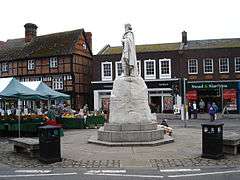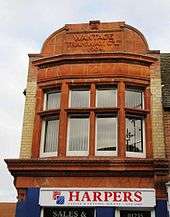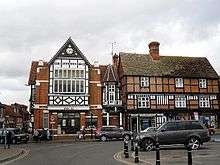Wantage
| Wantage | |
 Wantage Market Place and statue of King Alfred the Great |
|
 Wantage |
|
| Population | 11,327 (2011 census)[1] |
|---|---|
| OS grid reference | SU3987 |
| – London | 57 miles (92 km) |
| Civil parish | Wantage |
| District | Vale of White Horse |
| Shire county | Oxfordshire |
| Region | South East |
| Country | England |
| Sovereign state | United Kingdom |
| Post town | Wantage |
| Postcode district | OX12 |
| Dialling code | 01235 |
| Police | Thames Valley |
| Fire | Oxfordshire |
| Ambulance | South Central |
| EU Parliament | South East England |
| UK Parliament | Wantage |
| Website | Wantage.com Gateway to Wantage |
|
|
Coordinates: 51°35′20″N 1°25′37″W / 51.589°N 1.427°W
Wantage (/ˈwɒntɪdʒ/) is a market town and civil parish in the Vale of the White Horse, Oxfordshire, England. The town is on Letcombe Brook, about 8 miles (13 km) south-west of Abingdon, 10 miles (16 km) west of Didcot, 15 miles (24 km) south-west of Oxford and 14 miles (23 km) north north-west of Newbury.
Historically part of Berkshire, it is notable as the birthplace of King Alfred the Great in 849.[2] In 1974 the area administered by Berkshire County Council was greatly reduced, and Wantage, in common with other territories South of the River Thames, became part of a considerably enlarged Oxfordshire.
History

Wantage was a small Roman settlement[3] but the origin of the toponym is somewhat uncertain. It is generally thought to be from an Old English phrase meaning "decreasing river".[3] King Alfred the Great was born at the royal palace there in the 9th century.[2] Wantage appears in the Domesday Book of 1086. Its value was £61 and it was in the king's ownership until Richard I passed it to the Earl of Albemarle in 1190. Weekly trading rights were first granted to the town by Henry III in 1246[3] Markets are now held twice weekly on Wednesdays and Saturdays[4] Royalist troops were stationed in Wantage during the English Civil War.[3]
In the 19th century, Lord Wantage became a notable local and national benefactor.[5] He was very involved in founding the British Red Cross Society.[5] In 1877 he paid for a marble statue of King Alfred by Count Gleichen to be erected in Wantage market place, where it still stands today.[3][5] He also donated the Victoria Cross Gallery to the town.[3][5] This contained paintings by Louis William Desanges depicting deeds which led to the award of a number of VCs, including his own gained during the Crimean War. It is now a shopping arcade.[3] Since 1848, Wantage has been home to the Community of Saint Mary the Virgin, one of the largest communities of Anglican nuns in the world. Wantage once had two breweries which were taken over by Morlands of Abingdon. In 1988 the town was thrust into the headlines after a Brass Tacks programme entitled "Shire Wars"[6] exposed the drunken violence that plagued the town and surrounding villages at that time.
Government
_Offices%2C_Portway%2C_Wantage%2C_Oxon.jpg)
Wantage has a town council consisting of 16 councillors, 11 of whom (as of 2011) are Conservatives with the remaining five councillors being made up of four Liberal Democrats and one Labour Party. It is also part of the district of the Vale of White Horse.
Until 1974, Wantage had two local government councils: Wantage Rural District, which had its headquarters in Belmont,[7] Wantage and Wantage Urban District, which had its headquarters in Portway.[8] These bodies were both abolished as part of the Local Government Act 1972 and became part of the Vale of White Horse District Council.
Geography
Wantage is at the foot of the Berkshire Downs escarpment in the Vale of the White Horse. There are gallops at Black Bushes and nearby villages with racing stables at East Hendred, Letcombe Bassett, Lockinge and Uffington. Wantage includes the suburbs of Belmont to the west and Charlton to the east. Grove to the north is still just about detached and is a separate parish. Wantage parish stretches from the northern edge of its housing up onto the Downs in the south, covering Chain Hill, Edge Hill, Wantage Down, Furzewick Down and Lattin Down. The Edgehill Springs rise between Manor Road and Spike Lodge Farms and the Letcombe Brook flows through the town. Wantage is home to the Vale and Downland Museum. There is a large market square containing a statue of King Alfred, surrounded by shops some with 18th-century facades. Quieter streets radiate from it, including one towards the large Church of England parish church. Wantage is the "Alfredston" of Thomas Hardy's Jude the Obscure.[9]
Transport

Wantage is at the crossing of the B4507 valley road, the A417 road between Reading and Cirencester and the A338 road between Hungerford (and junction 14 of the M4 motorway) and Oxford.
Bus services link Wantage with Oxford as well as other towns and villages including Abingdon, Didcot and Faringdon. Stagecoach in Oxfordshire provide the main service between Wantage and Oxford.[10][11] Stagecoach provides a late night service on Friday and Saturday evenings with buses running to Oxford until 2am and buses from Oxford to Wantage until 3am. [12][13] There are also up to two buses per hour between Wantage and Didcot which are operated by Thames Travel,[14] Thames Travel also operate the Faringdon to Wantage service which runs up to every 60 minutes,[15] and a local service to Grove.[16]
There is no railway station in Wantage however Didcot Parkway is 8 miles east of Wantage, which has services towards London, Bristol and Cardiff. The Great Western Mainline is just north of Grove (2 miles North of Wantage) where the former Wantage Road railway station used to be. It was closed during the Beeching cuts in 1964. The Wantage Tramway used to link Wantage with Wantage Road station. The tramway's Wantage terminus was in Mill Street and its building survives, but little trace remains of the route. One of the tramway's locomotives, Shannon, alias Jane, is preserved at Didcot Railway Centre. In June 2014 Oxfordshire County Council outlined their plans and aspirations to re-open the former Wantage Road station which has now been added to their Local Transport Plan (LTP).[17] The Association of Train Operating Companies (ATOC) published their Connecting Communities: Expanding Access to the Rail Network report and outlined Wantage and Grove as one of the top seven places where a new station would be feasible and provide economical benefits to the area.[18]
A section of the Wilts & Berks Canal passes through the parish.
Education
There is one state secondary school in Wantage, King Alfred's Academy, and some ten primary schools. The secondary school recently converted into an academy and is currently rated Outstanding by Ofsted. A former independent preparatory school, St Andrew's, established in 1926, closed permanently in 2010. Between 1873 and 2007, an Anglican private girls' school, St Mary's School, was located in Wantage.
Architecture

Wantage has been the site of a church since at least the 10th century and the present Church of England parish church of Saints Peter and Paul dates from the 13th century, with many additions since.[19] SS Peter and Paul also contains seventeen 15th century misericords.[19]
King Alfred's Grammar School was designed by the architect J. B. Clacy[20] of Reading[21] and built in 1849–50[20] but incorporates a highly carved Norman doorway[20] from a demolished chantry chapel that formerly stood in the churchyard.[3][19]
Developments
In recent years four or more significant housing developments have been constructed. At least one development (including the new health centre) has been on a greenfield site adjacent to the A338 road towards Oxford. The other three, however, have been on brownfield sites, converting a scrapyard next to the Letcombe Brook.
In 2006, a commercial development began construction with a Sainsbury's supermarket as a focus. This supermarket is double the size of the previous one and was intended to have a significant impact on the town by drawing more visitors from outlying villages. The impact was projected as being positive, aimed at preventing the town becoming a commuter town and retaining some commercial activity, An action group, Wantage Rejuvenated, is being sponsored by the town's chamber of commerce to try to bring business back into the area and inject new life into the town.
There was activism in the town regarding development 2011, with a campaign to stop the demolition of a building close to the town centre by Vanderbuilt Homes, who initially gained permission to convert an early Georgian bank of shops into a mixed commercial and residential block. Vanderbilt applied to have the buildings completely demolished, prompting a local petition and campaign for the application to be refused at the discretion of the Town Council, as although the building is old, it is not listed.[22]
Another area of development which has provoked local protest has been on the north of the town, where a 1,500-home estate is proposed, increasing housing in the town by 35%. Residents have raised petitions and the local MP, Ed Vaizey, has raised concerns, especially about the ability of local road infrastructure to cope. The town is served by the A338, A4497 and A417, which are single-carriageway roads. The proposed Wantage development is one mile from a similar mass of 2,500 homes proposed for the village of Grove and which will use same road network.[23]
In 2014 Wantage was nominated for the Government's Great British High Street Award whereby Wantage won the award for Britain's Best Town Centre beating several other towns nominated for the award.[24]
Sport and leisure
Wantage has a non-League football club: Wantage Town F.C., who play at Alfredian Park.
On 12 September 2014, cyclists competing in the 2014 Tour of Britain passed through Wantage during Stage 6 of the event. The participants entered Wantage via the B4494 road and left via the A417 towards Harwell and then on towards the end of the stage at Hemel Hempstead.[25]
Notable people

- King Alfred the Great was born in Wantage in 849.[2]
- Leigh Bedwell, professional footballer (currently playing for Swindon Town), was born in Wantage in 1994.
- John Betjeman, Poet Laureate from 1972 to 1984, lived in Wantage and his book Archie and the Strict Baptists is based in the town. Wantage has a memorial park named after him, which includes extracts from his poems in a peaceful wooded area.
- Roy Burton, former Oxford United and Witney Town goalkeeper, was born in Wantage in 1951.
- Joseph Butler (1692–1752), Bishop of Bristol, Bishop of Durham, and author of The Analogy of Religion, was born and educated in Wantage.[26]
- William John Butler, Vicar of Wantage, Dean of Lincoln.
- Edward Cawston, former English cricketer, born in Wantage in 1911.
- Alice FitzWarin, wife of Dick Whittington, three-time Lord Mayor of the City of London, grew up in Wantage.[27] Her father's brass memorial is in the church.[28]
- Hugh Johns, former ITV football commentator, was born in Wantage in September 1922.
- Isaac Kimber, born Wantage, on 1 December 1692, English General Baptist minister, biographer, historian and journalist.
- Archie Kirkman Loyd, former MP, lived in Wantage during the 19th century.
- Robert Loyd-Lindsay, 1st Baron Wantage (see above).[3][5]
- Frances O'Connor, Anglo-Australian actor, was born in Wantage in 1967 where she lived for two years before moving to Perth, Australia.
- Lester Piggott, jockey, was born in Wantage in 1935.
- Thomas William Shore, former geologist and antiquarian, was born in Wantage in 1840.
Twinning
Wantage has been twinned with:
Nearby places
 |
Faringdon, Carterton, Witney | Grove | Abingdon, Oxford |  |
| Swindon | |
Didcot, Wallingford, London | ||
| ||||
| | ||||
| Lambourn | Hungerford | Newbury |
References
- ↑ http://www.whitehorsedc.gov.uk/node/11912
- 1 2 3 Ford, David Nash (2003). "King Alfred the Great (849–899)". Royal Berkshire History. Nash Ford Publishing. Retrieved 11 June 2011.
- 1 2 3 4 5 6 7 8 9 Ford, David Nash (2004). "Wantage: Where the Great are Born". Royal Berkshire History. Nash Ford Publishing. Retrieved 11 June 2011.
- ↑ "OXTowns: Wantage Local Information". OXLink Ltd. 2003. Retrieved 5 October 2011.
- 1 2 3 4 5 Ford, David Nash (2008). "Col. Sir Robert James Loyd-Lindsay, Baron Wantage of Lockinge (1832–1901)". Royal Berkshire History. Nash Ford Publishing. Retrieved 11 June 2011.
- ↑ "Brass Tacks: Shire Wars".
- ↑ "Wantage Rural District Council" (PDF). London Gazette. Retrieved 29 May 2012.
- ↑ "Wantage Urban District Council" (PDF). London Gazette. Retrieved 29 May 2012.
- ↑ Walking in the Thames Valley by Steve Davison
- ↑ https://www.stagecoachbus.com/getTimetable.ashx?code=XOAX030&dir=INBOUND&date=30%2f06%2f2015
- ↑ https://www.stagecoachbus.com/getTimetable.ashx?code=XOAO031&dir=INBOUND&date=30%2f06%2f2015
- ↑ https://www.stagecoachbus.com/getTimetable.ashx?code=XOAX030&dir=INBOUND&date=30%2f06%2f2015
- ↑ https://www.stagecoachbus.com/getTimetable.ashx?code=XOAO031&dir=INBOUND&date=30%2f06%2f2015
- ↑ http://assets.goaheadbus.com/media/cms_page_media/2016/7/18/X32-32A_July2016_WEB.pdf
- ↑ http://assets.goaheadbus.com/media/cms_page_media/2016/7/17/67-67C_July2016_WEB.pdf
- ↑ "38/38A". Thames Travel. 20 July 2016. Retrieved 14 August 2016.
- ↑ https://www.oxfordshire.gov.uk/cms/sites/default/files/folders/documents/roadsandtransport/transportpoliciesandplans/localtransportplan/ConnectingOxfordshirevol1policyandoverallstrategy.pdf
- ↑ http://www.atoc.org/clientfiles/files/publicationsdocuments/ConnectingCommunitiesReport_S10.pdf
- 1 2 3 Ford, David Nash (2004). "Wantage: St. Peter & St. Paul's Church". Royal Berkshire History. Nash Ford Publishing. Retrieved 11 June 2011.
- 1 2 3 Pevsner, 1966, page 254
- ↑ Brodie, Antonia; Felstead, Alison; Franklin, Jonathan; Pinfield, Leslie, eds. (2001). Directory of British Architects 1834–1914, A–K. London & New York: Continuum. p. 375. ISBN 0-8264-5513-1.
- ↑ Wantage and Grove Review Issue No 401. 3 October 2011. Missing or empty
|title=(help) - ↑ Ellery, Ben (8 December 2009). "Anger as Wantage is chosen for 1,500-home development". Oxford Mail. Retrieved 2 September 2013.
- ↑ "Team effort wins Wantage award for best town centre". The Herald. 12 November 2014. Retrieved 30 January 2015.
- ↑ http://www.cyclingweekly.co.uk/racing/tour-of-britain/tour-britain-2014-route-launched-119567
- ↑ Ford, David Nash (2003). "Joseph Butler, Bishop of Bristol (1692–1752)". Royal Berkshire History. Nash Ford Publishing. Retrieved 11 June 2011.
- ↑ Ford, David Nash (2003). "Alice FitzWarin (c.1375-c.1410)". Royal Berkshire History. Nash Ford Publishing. Retrieved 11 June 2011.
- ↑ Ford, David Nash (2001). "Sir Ivo FitzWarin (1343–1414)". Royal Berkshire History. Nash Ford Publishing. Retrieved 11 June 2011.
Sources and further reading
- Aston, Michael; Bond, James (1976). The Landscape of Towns. Archaeology in the Field Series. London: J.M. Dent & Sons Ltd. p. 96. ISBN 0-460-04194-0.
- Page, W.H.; Ditchfield, P.H., eds. (1924). A History of the County of Berkshire. Victoria County History. 4. assisted by John Hautenville Cope. London: The St Katherine Press. pp. 319–332.
- Pevsner, Nikolaus (1966). Berkshire. The Buildings of England. Harmondsworth: Penguin Books. pp. 252–256.
External links
| Wikimedia Commons has media related to Wantage. |
